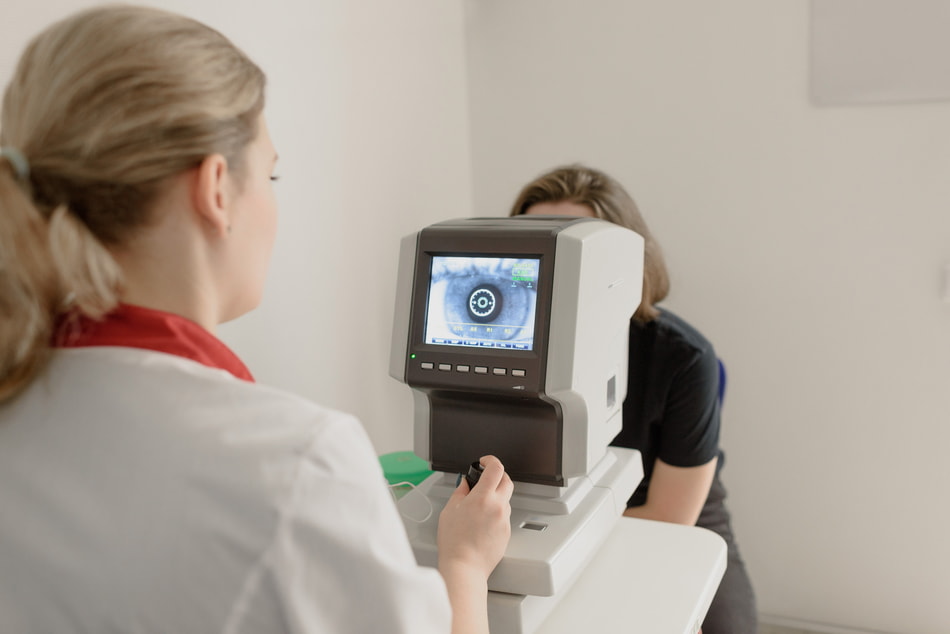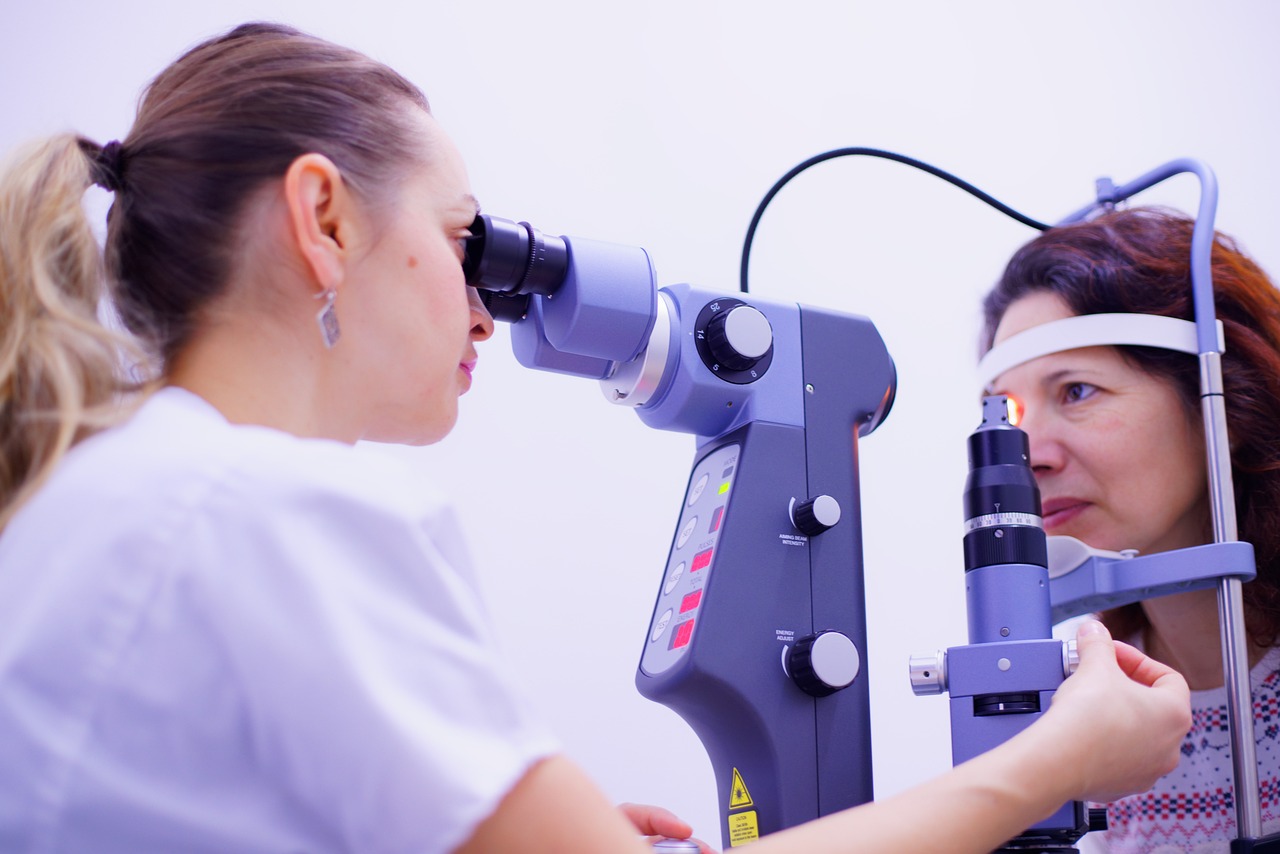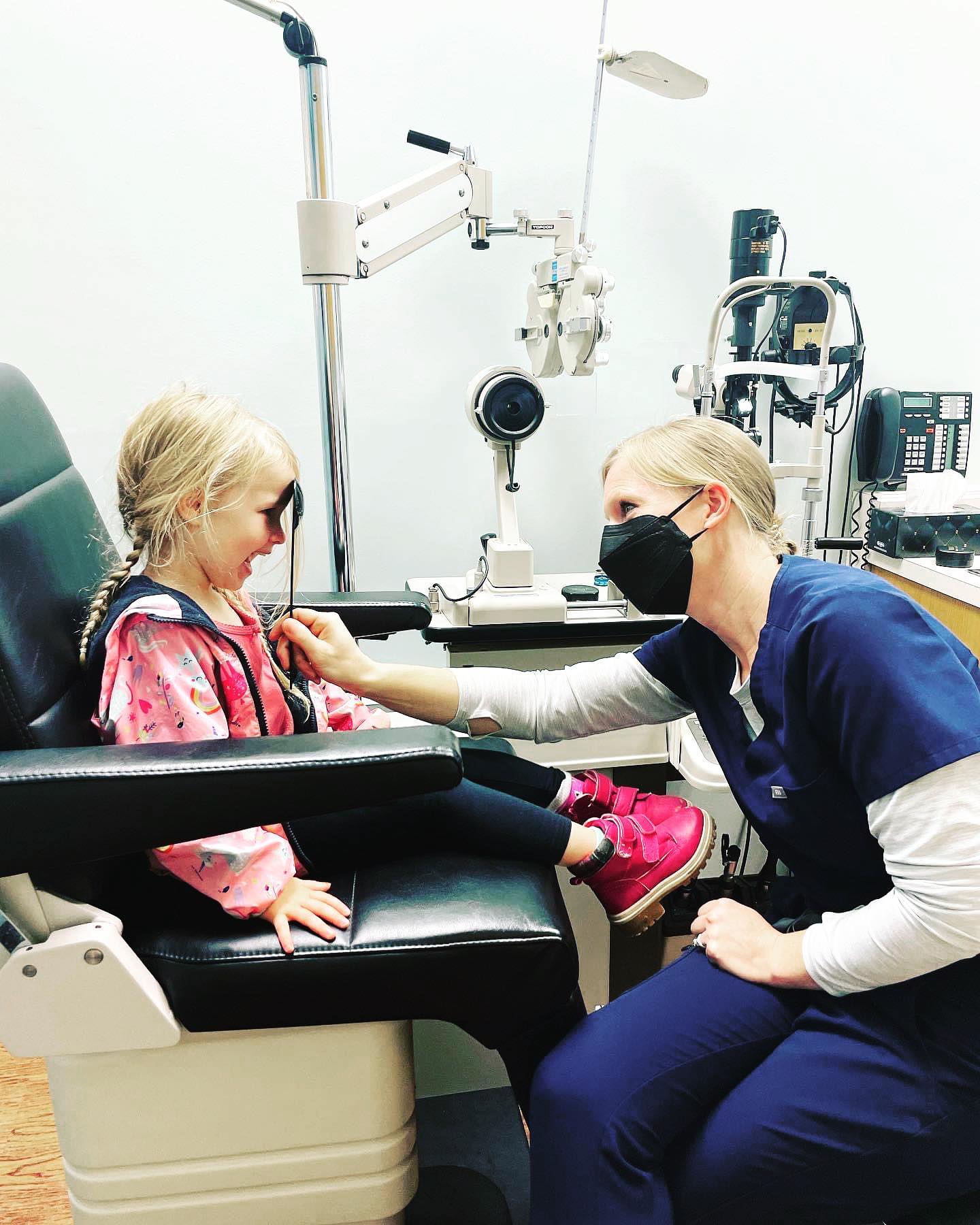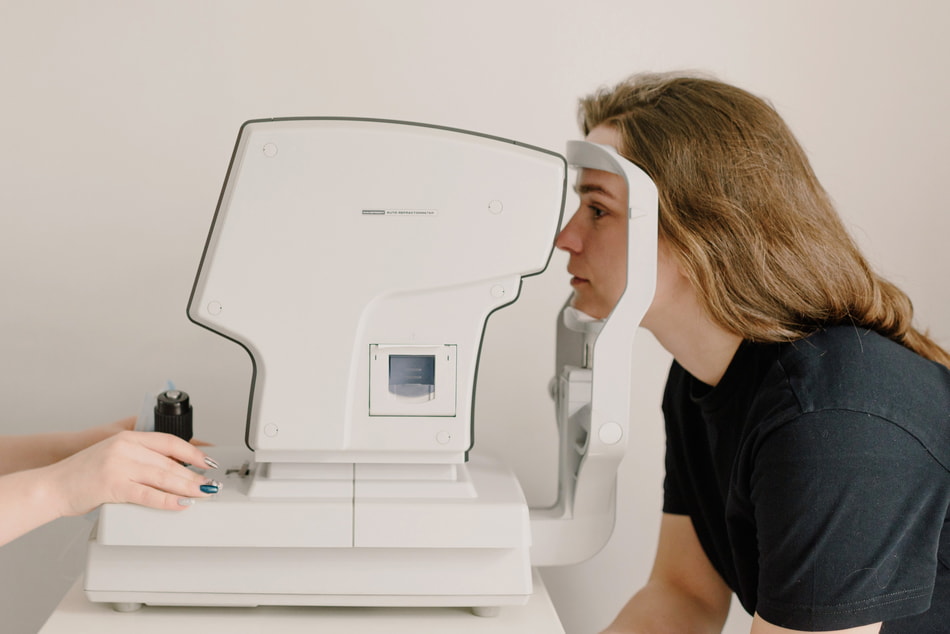Benefits of routine comprehensive eye exams
Did you know that seeing 20/20 does not necessarily mean that you have healthy eyes? Eye examinations go far beyond just how well you can see. During a routine comprehensive examination, your optometrist will a have a detailed look into your eye health which can give insight into not only the health of your eyes but your overall general health as well. The eyes are essential for many daily activities and proper eye care can help preserve your vision and prevent eye diseases that can lead to vision loss or blindness.

Some common eye conditions that can be prevented or treated with regular eye care include:
- Refractive errors: These include nearsightedness, farsightedness, and astigmatism, which can be corrected with glasses, contact lenses, or refractive surgery.
- Glaucoma: A group of eye diseases that damage the optic nerve and can cause vision loss or blindness. Early detection and treatment can prevent or slow down vision loss.
- Cataracts: A clouding of the lens in the eye that can cause blurred vision. Surgery is often used to remove cataracts and restore vision.
- Age-related macular degeneration: A disease that affects the macula, the part of the retina responsible for central vision. Early detection and treatment can slow down the progression of the disease.
- Diabetic retinopathy: A complication of diabetes that can damage the blood vessels in the retina and cause vision loss. Regular eye exams can help detect the disease early and prevent vision loss.
Regular eye exams, a healthy diet, and protection from UV rays can help maintain the health of your eyes and prevent vision problems.
During a comprehensive eye exam, your optometrist will perform a variety of tests. Some of these may include:
- Visual acuity: Measures your ability to see details at various distances
- Refraction: Your refractive error determines your need for glasses or contact lenses
- Muscle balance: Checks for proper eye alignment and coordination
- Tonometry: Measures eye pressure and is used to assess the risk of developing glaucoma and/or monitoring how well a glaucoma treatment regime is working
- Pachymetry: Measures the thickness of the cornea
- Dilated fundus exam: Eye drops are used to widen the pupils to give the best view of the full retina, macula and optic nerve for signs of disease or damage.
- Visual field test: Checks your peripheral vision and sensitivity of the optic nerve
- Retinal image and OCT: Our retinal camera takes a photo of the central part of the back of the eye to use for assessment at that examination and comparison for changes at future visits. The OCT, or optical coherence tomography, takes detailed scans of the layers of the back of the eye including the macula and optic nerve head providing your optometrist with a comprehensive view that would otherwise not be seen
Should children also have their eyes examined?
Yes, of course! For children, regular eye exams are especially important as undiagnosed vision problems can affect their learning and development. Early detection of issues like refractive errors, lazy eyes (also known as amblyopia), and eye turns (also known as strabismus), allows for timely treatment and management, minimizing any potential impact on their visual development. It is recommended that children have their first eye examination at 6 months of age and yearly thereafter.
Adult & Senior Eye Exams
Adults and seniors should undergo regular eye exams to maintain good eye health and detect any vision problems or eye diseases early.
Routine eye exams are recommended at regular intervals of 12-24 months depending on your age and the findings of your exam.
However, if you have certain risk factors for eye diseases, such glaucoma or diabetes, you may need more frequent eye exams. Your optometrist will recommend the appropriate frequency of eye exams based on your individual needs.

Diabetic Eye Exams
Diabetic eye exams are specialized eye exams that are performed to detect and monitor eye problems that are associated with diabetes. Diabetes can cause damage to the small blood vessels in the retina (the light-sensitive tissue at the back of the eye) which can lead to a condition called diabetic retinopathy. This condition can cause vision loss or even blindness if left untreated. Diabetes can also cause cataracts to form.

The Canadian Ophthalmological Society recommends that people with diabetes undergo a comprehensive dilated eye exam at least once a year. During this exam, special eye drops are used to dilate the pupils, allowing your optometrist to examine the retina and optic nerve for signs of damage or disease. In addition to this, a retinal image and OCT (as known as optical coherence tomography) are strongly recommended for all patients, especially those with diabetes, as these provide a more thorough evaluation of the health of the retina and are the best tool for early detection of diabetic related retinal changes.
In addition to regular eye examinations, it is important for people with diabetes to maintain good control of their blood sugar levels, blood pressure, and cholesterol levels to help reduce the risk of developing diabetic retinopathy.
Paediatric Eye Exams
Children’s eye care is very important as it helps to ensure that a child’s vision is developing properly and any issues are identified and addressed early. Babies should have their first eye examination at 6 months of age and every year afterwards.
Here are some tips for ensuring good eye health in children:
- Look for warning signs: Watch for any signs that your child might be having vision problems, such as squinting, learning difficulties at school, rubbing their eyes, or holding things very close to their face. If you notice any of these signs, schedule an eye exam right away.
- Encourage outdoor play: Spending time outside can help to reduce the risk of nearsightedness, so encourage your child to play outside as much as possible.
- Limit screen time: Too much screen time can lead to eye strain, dry eyes, and other problems. Try to limit your child’s screen time and encourage them to take frequent breaks.
- Provide good lighting: Make sure your child has good lighting when reading, writing, or doing other close-up work. Good lighting can help reduce eye strain.
- Sunglasses outdoors: UV protection is important year round for everyone but this is especially true for children as their crystalline lens is not as effective at filtering UV light as an adult’s lens. The effects of UV light are cumulative and it is estimated that up to 80% of a person’s lifetime UV exposure occurs by the age of 18. Put those sunglasses on!
- Use protective eyewear: Encourage your child to wear protective eyewear when playing sports or doing other activities that could potentially injure their eyes.

Contact Lens Exams

For all contact lens wearers and those who wish to wear contact lenses, contact lens examinations in addition to comprehensive eye exams are incredibly important. A prescription for eyeglasses is not the same as a contact lens prescription as glasses sit in front of the eye and contact lenses sit directly on the eye. This may alter the strength of prescription required. When deciding on the best contact lens option for you, your optometrist will go through an extensive selection process considering various factors including prescription, material, curvature, diameter, fit, coating, oxygen permeability, deposit resistance, moisture content, cleaning solution, and lifespan of the lens. They will assess your vision in the contact lenses to ensure they are providing you with the best vision possible, fitting and moving on your eyes correctly, comfortable to wear and not causing any ocular complications. Contact lenses are Health Canada approved and FDA regulated medical devices and as such, it is important that they are fit and regularly examined by a licensed eye care professional. Poor fit and improper use can damage the health of your eyes and potentially lead to blindness.
Digital Eye Strain
Digital eye strain, also known as computer vision syndrome, is a condition that occurs when the eyes are exposed to prolonged use of digital devices such as computers, smartphones, tablets, and televisions.
- The symptoms of digital eye strain may include eyestrain, headaches, dry eyes, blurred vision, and neck and shoulder pain.
The blue light emitted from digital devices is known to be a cause of digital eye strain. Other factors that can contribute to the condition include poor lighting, glare, improper viewing distance, and poor posture while using digital devices. To prevent digital eye strain, it’s recommended to take regular breaks, adjust the display settings on digital devices, use proper lighting, and maintain a healthy distance between the eyes and the screen.

Laser Eye Surgery Consultation

Ever wondered what it would be like to be free of glasses? Our optometrists can help you decide if refractive eye surgery is an appropriate option for you. During a pre-operative refractive surgery assessment, we will evaluate your eye health and determine if you are a good candidate for refractive eye surgery. Your optometrist will also discuss with you the different types of refractive eye surgery available, including LASIK, PRK, SMILE, ICL and refractive lens exchange, and recommend which options are best suited for your eyes and individual needs and preferences.
- The consultation typically begins with a comprehensive eye exam to assess the health of your eyes and measure your vision. Detailed measurements of your eyes are taken to determine the suitability of your eyes for surgery. A longer lasting type of dilating eye drop will likely also be used during this appointment. You will also be asked about your medical history and any medications you are taking. If you wear contact lenses, you may need to stop wearing them for a period of time before the consultation to allow your corneas to return to their natural shape.
If you decide to proceed with refractive eye surgery, your optometrist will schedule a consultation with your chosen eye surgeon who will provide you with detailed instructions on how to prepare for it. After your surgery and post-operative care is completed at your surgery centre, you will continue the rest of your post-operative care with your referring optometrist who will monitor your progress and ensure that your eyes are healing properly.
Eye Disease Diagnosis & Management
Many eye diseases have no symptoms in the early stages and can remain undetected without routine comprehensive eye examinations. While many eye diseases are treatable, some have no cure. However, most conditions have the best prognosis if detected, treated and/or managed in their early stages. Our team of optometrists use their extensive expertise together with advanced diagnostic equipment (including retinal imaging, optical coherence tomography, tonometry, pachymetry and automated visual perimetry) to aid in the early diagnosis of conditions. Our primary goal is to keep you seeing your best and your eyes healthy for as long as possible. A few of the most common eye diseases your optometrist can diagnose are glaucoma, age-related macular degeneration, cataracts and diabetic retinopathy. Treatment options may include lifestyle changes, medications, surgery or a combination of these options. Some things you can do to help preserve the health of your eyes, in addition to regular eye care, include ensuring you wear UV protection when outdoors even on cloudy days, wearing appropriate eye protection when required, wearing and caring for your contact lenses appropriately, not smoking and maintaining a healthy lifestyle including regular exercise and nutritional food choices.








